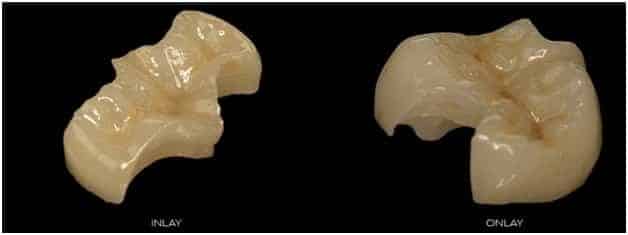Inlays and Onlays are one of Dr. Goodman’s cosmetic specialties. When it comes to treating decay there are many options:
- Amalgam (mercury) fillings: Silver looking fillings, which are not done in our office.
- Resin fillings, bonding: White fillings, which are very popular and only require one visit. They can be done on small to medium sized cavities. The teeth are filled instantly and you can eat and chew right after you leave the office.
- Inlays and Onlays : Done in 2 steps. In the 1st step, Dr. Goodman removes the cavity, cleans the tooth, and an impression will be taken. You will leave the office with a temporary filling and come back a few days later. During your second visit our high quality dental lab will deliver the porcelain filling (Inlay, Onlay) to our office.
There are many options of what this material of choice can be, and the options are too numerous to list all of them. As a general guideline you can choose:
- Gold Inlay (in back upper teeth): can last decades, barely visible.
- Porcelain Inlay (tooth colored): can last a long time, very biocompatible and strong, looks beautiful.
- Special Reinforced Resin (tooth colored fillings): very strong and durable and flexible to pressure from chewing and grinding.
- Hybrids (a combination of porcelain and resin fillings in one): there is an advantage to combining the positive physical properties of both into one filling.
In any case, the outcome of lab fabricated restorations is a more precise and more accurate restoration than with a resin filling done in one visit. The outcome is a perfectly contoured, beautiful, strong, and long-lasting restoration. An onlay is a bigger version of an inlay; when the decay is too big, an onlay can be suitable. If there is decay all over the tooth, a crown (cap) will be the best option.

The picture above shows the difference between and inlay and onlay. An onlay covers a larger part of the area and extends the border of the tooth; whereas inlays cover a smaller surface of the tooth.
What are Tooth Inlays and Onlays
Superior Fit: Inlays and onlays offer a conservative preparation that preserves as much healthy tooth as possible. They are a great choice if you have minimal to moderate tooth decay that extends into a flossing area, offering an excellent alternative to full coverage crowns.
Tooth Color: Boasting esthetic longevity, inlays and onlays are not likely to discolor over time as tooth-colored resin fillings often do.
Tooth Structure Safeguard: Inlays and onlays preserve the maximum amount of healthy tooth structure while restoring decayed or damaged areas, helping to ensure functional longevity.
Weak Tooth Protector: An onlay can protect the weak areas of the tooth. The procedure does not require the complete reshaping of the tooth.
Easy Tooth Cleaning: Because the fit is tailored at all edges and the preparation minimal, your tooth can be easier to clean than it would be with full coverage restorative alternatives such as a dental crown. Composite fillings can shrink during the curing process, whereas prefabricated porcelain or gold inlays and onlays will not (ensuring a precise fit).
Tight Space Fulfillments: If you have a cavity between your teeth, consider an inlay rather than a direct composite filling. Inlays are better at sealing teeth to keep out bacteria; they are easy to clean, will not stain and offer exceptional longevity.
Strength and Stability: Inlays and onlays are extremely stable restorative solutions for the treatment of decay. The superior fit and durable material make inlays and onlays a stable choice that can actually strengthen a damaged tooth.